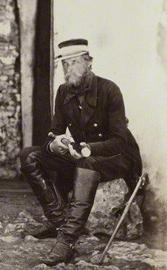Richard Dacres (British Army officer) facts for kids
Quick facts for kids
Sir Richard James Dacres
|
|
|---|---|

Sir Richard Dacres
|
|
| Born | 1799 |
| Died | 6 December 1886 (aged 86 or 87) Brighton |
| Allegiance | |
| Service/ |
|
| Years of service | 1817–1884 |
| Rank | Field Marshal |
| Battles/wars | Battle of Alma Battle of Balaclava Battle of Inkerman Siege of Sevastopol |
| Awards | Knight Grand Cross of the Order of the Bath Commander of the Order of Savoy Commander of the Légion d'honneur Second Class of the Order of Medjidie |
| Relations | Richard Dacres (father) Sydney Dacres (brother) James Richard Dacres (uncle) Barrington Dacres (cousin) James Richard Dacres (cousin) |
Sir Richard James Dacres (1799 – 6 December 1886) was a very important officer in the British Army during the 1800s. He came from a family famous for its naval heroes. Richard James became just as famous in the army.
He led three groups of special artillery soldiers, called the Royal Horse Artillery. He commanded them in major battles like the Battles of Alma, Balaclava, and Inkerman in 1854. He also served during the long Siege of Sevastopol. All these events happened during the Crimean War. Sir Richard eventually became a field marshal, which is the highest rank in the army.
Contents
Early Life and Family History
Richard James Dacres was born in 1799. His father, Richard Dacres, became a vice-admiral in the Royal Navy. The Dacres family had a long history of serving in the navy.
Richard James's uncle, James Richard Dacres, was also a vice-admiral. His cousins, Barrington Dacres and James Richard Dacres, also served in the navy. His younger brother, Sydney Dacres, became an Admiral and a very senior naval leader.
Richard James chose a different path. He went to the Royal Military Academy, Woolwich, in 1815. He joined the Royal Artillery as a second lieutenant in December 1817, starting his army career.
A Distinguished Military Career
Dacres moved up the ranks steadily. He became a first lieutenant in 1825 and a second captain in 1837. In 1843, he joined the Royal Horse Artillery. He was promoted to major in 1851 and lieutenant-colonel in 1852.
He was chosen to lead three groups of Royal Horse Artillery soldiers in the Crimean War. His forces worked with the cavalry, led by Lord Lucan.
Leading in the Crimean War
Dacres led his soldiers in several important battles:
- The Battle of Alma in September 1854.
- The Battle of Balaclava in October 1854.
- The Battle of Inkerman in November 1854.
He also served throughout the long Siege of Sevastopol. During the Battle of Balaclava, he was at the main army headquarters. His horse was even killed right under him! When another general was killed, Dacres took over command of all the artillery in the Crimea. He held this important job until the war ended.
Awards and Later Service
For his bravery and leadership, Dacres received many honors. He was made a Knight Commander of the Bath in 1855. This was for his success in capturing enemy artillery at Sevastopol. He also received awards from other countries:
- Commander of the Order of Savoy (Italy)
- Commander of the Légion d'honneur (France)
- Second Class of the Order of Medjidie (Ottoman Empire)
After the war, Dacres continued his service. He was put in charge of the Woolwich district, an important army training area, from 1859 to 1865. He became a lieutenant general in 1864. In 1869, he received an even higher honor, becoming a Knight Grand Cross of the Order of the Bath.
He retired from active service in 1877. However, he was then appointed Constable of the Tower in 1881. This is a very old and respected position at the Tower of London. While he was Constable, the Tower was attacked in 1885, causing some damage. In 1882, he also became the master gunner of England.
Sir Richard James Dacres was made a field marshal in July 1886. He passed away in Brighton on 6 December 1886, at the age of 87.
Personal Life
Dacres married Frances Brooking Thomas in St. John's, Newfoundland, on 3 November 1840. She was the granddaughter of William Bevil Thomas.
Images for kids
| Honorary titles
|
||
|---|---|---|
| Preceded by Sir William Fenwick Williams, Bt |
Constable of the Tower Lord Lieutenant of the Tower Hamlets 1881–1886 |
Succeeded by The Lord Napier of Magdala |


